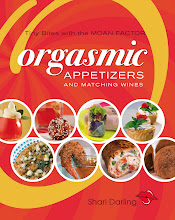
I am Canada's only aboriginal wine writer. So, it may come as no surprise that I have a soft spot for Nk'Mip Cellars (pronounced 'in-ka-meep'), Canada’s only aboriginal owned and operated winery. (http://www.nkmipcellars.com/).
This winery also happens to produce a list of outstanding and award winning wines. I've visited the winery on several occassions and am impressed with both the value and consistency of quality from year to year of both their whites and reds.
While I was touring this stunning place, located on the Osoyoos Reservation in the Okanogan Valley, B.C., I experienced an interesting, Native crispy bread made by the aboriginal in-house chef. (Most of the staff are native Canadians.) The bread was served with a chickpea dip. This wasn't pannock, the doughy pancake I grew up on, but rather a style of bread similar to India's poori. It is a thin, crispy unleavened, fried flatbread.
I sat on the patio over looking the steep vineyard dipping into the blues of Osoyoos Lake and crunched on my bread, all the while sipping Nk'Mip's Pinot Blanc. (I’ve included the bread recipe below. )
This bread can be served with a variety of dips, such as hummus, tzatziki, artichoke and white bean. An ideal starter for barbecue dining, this bread and dip combination can also be successfully partnered with a refreshing, chilled sauvignon blanc, pinot blanc, pinot gris or pinot grigio. These wines possess crisp acidity that naturally complements the crisp texture of the bread. The bread also has a hint of spice from the black pepper and cayenne, just enough to lift the tangy flavours in these wines.
Homemade dips always taste better. To make homemade hummus, use one can of garbanzo beans, a handful of chopped parsley, two or three green onions, two cloves of garlic, two tablespoons of tahini, two tablespoons of fresh lemon juice and salt and pepper to taste. Place all the ingredients in a food processor or blender, and with the motor running, add a steady stream of olive oil until the mixture is pureed until smooth.
To make tzatziki place a half-cup of plain homemade yogurt in a coffee filter over a bowl to drain over night in the refrigerator. Place thickened yogurt, two to three cloves of garlic, two tablespoons of fresh lemon juice and salt and pepper to taste into a food processor or blender. With the motor running, add a steady stream of olive oil until the mixture is pureed until smooth. Fold in half of a peeled, chopped cucumber and a teaspoon of fresh dill.
This artichokes dip is wonderfully tasty. Place a can of artichoke hearts in a blender or food processor with a handful of fresh cilantro, two tablespoons of fresh lemon juice, two cloves of garlic and salt and pepper to taste. With the motor running, add a steady stream of olive oil to puree the mixture until smooth.
The white bean dip is just as easy to prepare. Place a can of white beans in a food processor or blender, along with a half teaspoon of ground cumin, black pepper, two tablespoons of fresh lemon juice and salt and pepper to taste. With the motor running, add a steady stream of olive oil to puree the mixture until smooth.
The dips all offer tanginess from the lemon, thus harmonizing with the list of crisp, dry white wines above. The dips can also be made in less than 15 minutes, covered with plastic wrap and refrigerated, along with the wine, until your guests arrive. This bread can be prepared in advance, as well.
Osoyoos Crisp Bread
Four cups of all purpose flour (sifted)
Quarter cup shortening (lard)
One tablespoon salt
One tablespoon garlic powder
One tablespoon paprika
One teaspoon cayenne pepper
One teaspoon ground black pepper
Two tablespoons baking powder
One cup cold water
Sift all dry ingredients together. Cut the lard into the flour mixture. Slowly add the cold water until a dough ball comes together. Kneed the dough for at least five minutes. Portion dough into four parts and roll into balls. Wrap dough balls in plastic wrap and let rest for ten minutes. Roll out each ball as thin as possible. (This will take some work. Use little flour when rolling out the dough). Cut abour four ½ inch slits in the dough and place on two baking sheets sprayed with non-stick cooking spray. (The purpose of slits is to keep the dough from rising and therefore flat and crispy. Bake at 400 degrees F. for fifteen to twenty minutes or until bread is golden brown and crispy.
This bread can be served with a variety of dips, such as hummus, tzatziki, artichoke and white bean. An ideal starter for barbecue dining, this bread and dip combination can also be successfully partnered with a refreshing, chilled sauvignon blanc, pinot blanc, pinot gris or pinot grigio. These wines possess crisp acidity that naturally complements the crisp texture of the bread. The bread also has a hint of spice from the black pepper and cayenne, just enough to lift the tangy flavours in these wines.
Homemade dips always taste better. To make homemade hummus, use one can of garbanzo beans, a handful of chopped parsley, two or three green onions, two cloves of garlic, two tablespoons of tahini, two tablespoons of fresh lemon juice and salt and pepper to taste. Place all the ingredients in a food processor or blender, and with the motor running, add a steady stream of olive oil until the mixture is pureed until smooth.
To make tzatziki place a half-cup of plain homemade yogurt in a coffee filter over a bowl to drain over night in the refrigerator. Place thickened yogurt, two to three cloves of garlic, two tablespoons of fresh lemon juice and salt and pepper to taste into a food processor or blender. With the motor running, add a steady stream of olive oil until the mixture is pureed until smooth. Fold in half of a peeled, chopped cucumber and a teaspoon of fresh dill.
This artichokes dip is wonderfully tasty. Place a can of artichoke hearts in a blender or food processor with a handful of fresh cilantro, two tablespoons of fresh lemon juice, two cloves of garlic and salt and pepper to taste. With the motor running, add a steady stream of olive oil to puree the mixture until smooth.
The white bean dip is just as easy to prepare. Place a can of white beans in a food processor or blender, along with a half teaspoon of ground cumin, black pepper, two tablespoons of fresh lemon juice and salt and pepper to taste. With the motor running, add a steady stream of olive oil to puree the mixture until smooth.
The dips all offer tanginess from the lemon, thus harmonizing with the list of crisp, dry white wines above. The dips can also be made in less than 15 minutes, covered with plastic wrap and refrigerated, along with the wine, until your guests arrive. This bread can be prepared in advance, as well.
Osoyoos Crisp Bread
Four cups of all purpose flour (sifted)
Quarter cup shortening (lard)
One tablespoon salt
One tablespoon garlic powder
One tablespoon paprika
One teaspoon cayenne pepper
One teaspoon ground black pepper
Two tablespoons baking powder
One cup cold water
Sift all dry ingredients together. Cut the lard into the flour mixture. Slowly add the cold water until a dough ball comes together. Kneed the dough for at least five minutes. Portion dough into four parts and roll into balls. Wrap dough balls in plastic wrap and let rest for ten minutes. Roll out each ball as thin as possible. (This will take some work. Use little flour when rolling out the dough). Cut abour four ½ inch slits in the dough and place on two baking sheets sprayed with non-stick cooking spray. (The purpose of slits is to keep the dough from rising and therefore flat and crispy. Bake at 400 degrees F. for fifteen to twenty minutes or until bread is golden brown and crispy.












